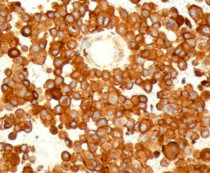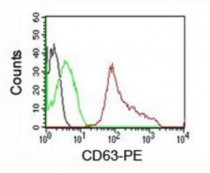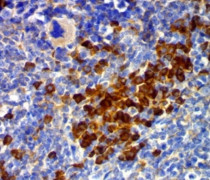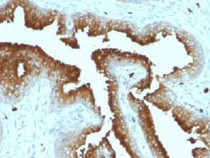anti-CD63 antibody [MX-49.129.5]
| 产品描述 | Mouse Monoclonal antibody [MX-49.129.5] recognizes CD63 |
|---|---|
| 反应物种 | Hu, Ms |
| 应用 | FACS, ICC/IF, IHC-P, WB |
| 宿主 | Mouse |
| 克隆 | Monoclonal |
| 克隆号 | MX-49.129.5 |
| 同位型 | IgG1, kappa |
| 靶点名称 | CD63 |
| 抗原物种 | Human |
| 抗原 | Full length Human CD63. |
| 偶联标记 | Un-conjugated |
| 別名 | Tspan-30; CD63 antigen; Tetraspanin-30; CD antigen CD63; Lysosomal-associated membrane protein 3; OMA81H; Ocular melanoma-associated antigen; Granulophysin; TSPAN30; Melanoma-associated antigen ME491; MLA1; LAMP-3; ME491 |
| 应用建议 |
| ||||||||||
|---|---|---|---|---|---|---|---|---|---|---|---|
| 应用说明 | IHC-P: Antigen Retrieval: Boil tissue section in 10 mM Citrate buffer (pH 6.0) for 10-20 min, followed by cooling at RT for 20 min. * The dilutions indicate recommended starting dilutions and the optimal dilutions or concentrations should be determined by the scientist. |
| 形式 | Liquid |
|---|---|
| 纯化 | Purification with Protein G. |
| 缓冲液 | PBS (pH 7.4), 0.05% Sodium azide and 0.1 mg/ml BSA. |
| 抗菌剂 | 0.05% Sodium azide |
| 稳定剂 | 0.1 mg/ml BSA |
| 浓度 | 0.2 mg/ml |
| 存放说明 | For continuous use, store undiluted antibody at 2-8°C for up to a week. For long-term storage, aliquot and store at -20°C or below. Storage in frost free freezers is not recommended. Avoid repeated freeze/thaw cycles. Suggest spin the vial prior to opening. The antibody solution should be gently mixed before use. |
| 注意事项 | For laboratory research only, not for drug, diagnostic or other use. |
| 数据库连接 | |
|---|---|
| 基因名称 | CD63 |
| 全名 | CD63 molecule |
| 背景介绍 | The protein encoded by this gene is a member of the transmembrane 4 superfamily, also known as the tetraspanin family. Most of these members are cell-surface proteins that are characterized by the presence of four hydrophobic domains. The proteins mediate signal transduction events that play a role in the regulation of cell development, activation, growth and motility. The encoded protein is a cell surface glycoprotein that is known to complex with integrins. It may function as a blood platelet activation marker. Deficiency of this protein is associated with Hermansky-Pudlak syndrome. Also this gene has been associated with tumor progression. Alternative splicing results in multiple transcript variants encoding different protein isoforms. [provided by RefSeq, Apr 2012] |
| 生物功能 | Functions as cell surface receptor for TIMP1 and plays a role in the activation of cellular signaling cascades. Plays a role in the activation of ITGB1 and integrin signaling, leading to the activation of AKT, FAK/PTK2 and MAP kinases. Promotes cell survival, reorganization of the actin cytoskeleton, cell adhesion, spreading and migration, via its role in the activation of AKT and FAK/PTK2. Plays a role in VEGFA signaling via its role in regulating the internalization of KDR/VEGFR2. Plays a role in intracellular vesicular transport processes, and is required for normal trafficking of the PMEL luminal domain that is essential for the development and maturation of melanocytes. Plays a role in the adhesion of leukocytes onto endothelial cells via its role in the regulation of SELP trafficking. May play a role in mast cell degranulation in response to Ms4a2/FceRI stimulation, but not in mast cell degranulation in response to other stimuli. [UniProt] |
| 细胞定位 | Cell membrane; Multi-pass membrane protein. Lysosome membrane; Multi-pass membrane protein. Late endosome membrane; Multi-pass membrane protein. Endosome, multivesicular body. Melanosome. Secreted, exosome. Cell surface. Note=Also found in Weibel-Palade bodies of endothelial cells (PubMed:10793155). Located in platelet dense granules (PubMed:7682577). Detected in a subset of pre-melanosomes. Detected on intralumenal vesicles (ILVs) within multivesicular bodies (PubMed:21962903). [UniProt] |
| 产品亮点 | Related products: CD63 antibodies; Anti-Mouse IgG secondary antibodies; Related news: New antibodies for exosome isolation |
| 预测分子量 | 26 kDa |
| 翻译后修饰 | Palmitoylated at a low, basal level in unstimulated platelets. The level of palmitoylation increases when platelets are activated by thrombin (in vitro). [UniProt] |
ARG41312 anti-CD63 antibody [MX-49.129.5] ICC/IF image
Immunofluorescence: HeLa cells stained with Alexa Fluor 488-conjugated ARG41312 anti-CD63 antibody [MX-49.129.5] (green). F-actin filaments are labeled with Dylight 554 phalloidin (red). DAPI (blue) for nuclear staining.
ARG41312 anti-CD63 antibody [MX-49.129.5] IHC-P image
Immunohistochemistry: Paraffin-embedded Human melanoma tissue stained with ARG41312 anti-CD63 antibody [MX-49.129.5].
ARG41312 anti-CD63 antibody [MX-49.129.5] WB image
Western blot: Human spleen lysate stained with ARG41312 anti-CD63 antibody [MX-49.129.5] at 2 µg/ml dilution.
ARG41312 anti-CD63 antibody [MX-49.129.5] FACS image
Flow Cytometry: Human PBMC cells stained with PE-conjugated ARG41312 anti-CD63 antibody [MX-49.129.5] (red). Cells alone (black). Isotype control (green).
ARG41312 anti-CD63 antibody [MX-49.129.5] IHC-P image
Immunohistochemistry: Paraffin-embedded Mouse spleen tissue stained with ARG41312 anti-CD63 antibody [MX-49.129.5].
ARG41312 anti-CD63 antibody [MX-49.129.5] IHC-P image
Immunohistochemistry: Formalin-fixed and paraffin-embedded prostate carcinoma tissue stained with ARG41312 anti-CD63 antibody [MX-49.129.5].
ARG41312 anti-CD63 antibody [MX-49.129.5] FACS image
Flow Cytometry: NIH/3T3 cells stained with PE-conjugated ARG41312 anti-CD63 antibody [MX-49.129.5] (red). Cells alone (black). Isotype control (green).
 New Products
New Products




![anti-CD63 antibody [MX-49.129.5]](/upload/image/products/ARG41312_FACS_NIH3T3_210_205.jpg)
![anti-CD63 antibody [MX-49.129.5]](/upload/image/products/ARG41312_IF_HeLa.jpg)
![anti-CD63 antibody [MX-49.129.5]](/upload/image/products/ARG41312_IHC-P_Hu-Melanoma.jpg)
![anti-CD63 antibody [MX-49.129.5]](/upload/image/products/ARG41312_WB_Hu-Spleen.jpg)
![anti-CD63 antibody [MX-49.129.5]](/upload/image/products/ARG41312_FACS_PBMC.jpg)
![anti-CD63 antibody [MX-49.129.5]](/upload/image/products/ARG41312_IHC-P_Ms-spleen.jpg)
![anti-CD63 antibody [MX-49.129.5]](/upload/image/products/ARG41312_IHC-P_prostate.jpg)
![anti-CD63 antibody [MX-49.129.5]](/upload/image/products/ARG41312_FACS_NIH3T3.jpg)























